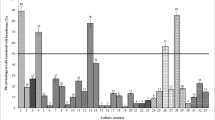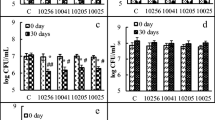Abstract
A lactic acid bacteria Leuconostoc paramesenteroides was isolated and characterized from cheddar cheese and was adapted to grow at low pH (2.0) and high bile salt concentration (2%) by sequential sub-culturing so that it can survive the extreme environmental condition of gut. Cell hydrophobicity assay shows the maximum adherence of the culture to toluene (46.11%). Adhesion ability was confirmed by in vitro assay using rat intestinal epithelial layer. The culture has an antimicrobial activity against food borne pathogens and is vancomycin sensitive. The culture shows a β-galactosidase activity of 3.42 μM/mg protein, which indicates the ability of the culture to hydrolyze lactose for easy absorption. All these properties determine the ability of the culture to be used as a probiotic.


Similar content being viewed by others
References
Alsopp D, Colwell RR, Howksworth DL (1995) In: Proceedings of the IUBS/IUMS workshop held at Egham, UK, 10–13 Aug 1993 in support of the IUBS/UNESCO/SCOPE “DIVERSITAS” programme. CEB International, University Press, Cambridge, UK
Gilliland SE (1987) Importance of bile tolerance in Lactobacilli used as dietary adjunct. In: Lyons TP (ed) Biotechnology in the feed industry. All Tech Co., Lexington, pp 149–155
Peterson SD, Marshall RT, Heymann H (1990) Peptidase profiling of Lactobacilli associated with cheddar cheese and its application to identification and selection of strain of cheese ripening studies. J Dairy Sci 73:1454–1464
Salminen S, Laino M, Von Wright A, Vuopio-Varkila J, Korhonon T, Mattila-Sandholm T (1996) Development of selection criteria for probiotic strains to assess their potential in functional foods: a Nordic and European approach. Biosci Microflora 15:61–67
Swearingen PA, O’Sullivan DJ, Warthesen JJ (2001) Isolation, characterization and influence of native, non starter lactic acid bacteria on cheddar cheese quality. J Dairy Sci 84:50–59
Krieg N (ed) (1984) Bergey’s manual of systematic bacteriology, vol 2. Williams and Wilkins, Baltimore
Herrero M, Mayo B, Gonzalez B, Suarez JE (1996) Evaluation of technologically important traits in lactic acid bacteria isolated from spontaneous fermentation. J Appl Bacteriol 81:565–570
Terzaghi BE, Sandine WE (1975) Improved medium for lactic Streptococci and their bacteriophages. Appl Microbiol 29:807–813
Smibert RM, Krieg NR (1981) General characterization. In: Gerhardt P, Murray RGE, Costilow RN, Nester EW, Wood WA, Krieg NR, Briggs Phillips G (eds) Manual of methods for general bacteriology. ASM press, Washington, pp 409–443
Chelo IM, Ze-Ze L, Chambel L, Tenreiro R (2004) Physicla and genetic map of Weissella paramesenteroides DSMZ 20288 chromosome and characterization of different rrn operon by ITS analysis. Microbiol 150:4075–4084
Rosenberg M, Gutnick D, Rosenberg E (1980) Adherence of bacteria to hydrocarbons: a simple method for measuring cell-surface hydrophobicity. FEMS Microbiol Lett 9:29–33
Mayra-Makinen A, Manninen M, Gyllenberg H (1983) The adherence of lactic acid bacteria to the columnar epithelial cells of pigs and calves. J Appl Bacteriol 55:241–245
Bhowmik T, Marth EH (1989) Simple method to detect β-galactosidase. Appl Environ Microbiol 55:3240–3242
Castro HP, Teixeira PM, Kirby R (1997) Evidence of membrane damage in Lactobacillus bulgaricus following freeze drying. J Appl Microbiol 82:87–94
Lowry OH, Rosenbrough NJ, Farr AL, Randall RJ (1951) Protein estimation with the folin phenol (ciocalteau) reagent. J Biol Chem 193:265–271
Brashears MM, Durre WA (1999) Antagonistic action of Lactobacillus lactis toward Salmonella spp and Escherichia coli 0151:H7 during growth and refrigerated storage. J Food Prot 62:1336–1340
Schillinnger U, Lucke FK (1989) Antibacterial activity of Lactobacillus sake isolated from meat. Appl Environ Microbiol 55:1901–1906
Tserovska L, Stefanova S, Yordanova T (2002) Identification of lactic acid bacteria isolated from katyk, goat’s milk and cheese. J Cult Collect 3:48–52
Beukes EM, Bester BH, Mostert JF (2001) The microbiology of South African traditional fermented milks. Int J Food Microbiol 63(3):189–197
Savadogo A, Ouattara CAT, Savadogo PW, Ouattara AS, Barro N, Traore AS (2004) Microorganisms involved in fulani traditional fermented Milk in Burkina Faso. Pak J Nutr 3(2):134–139
Thompson JD, Higgins DG, Gibson TJ (1994) CLUSTAL W: improving the sensitivity of progressive multiple sequence alignment through sequence weighting, position-specific gap penalties and weight matrix choice. Nucleic Acids Res 22:4673–4680
Chung HS, Kim YB, Chun SL, Ji GE (1999) Screening and selection of acid and bile resistant Bifidobacteria. Int J Food Microbiol 47:25–32
Grill JP, Schneider F, Crociani J, Ballongue J (1995) Purification and characterization of conjugated bile salt hydrolase from Bifidobacterium longum BB536. Appl Environ Microbiol 61:2577–2582
Margolles A, Garcia L, Sanchez B, Gueimonde M, de los Reyes-Gavilan CG (2003) Characterisation of a Bifidobacterium strain with acquired resistance to cholate: a preliminary study. Int J Food Microbiol 82(2):191–198
Conway PL, Gorbach SL, Goldin BR (1987) Survival of lactic acid bacteria in the human stomach by adhesion to intestinal cells. J Dairy Sci 70:1–12
Lankaputhra WEV, Shah NP (1995) Survival of Lactobacillus acidophilus and Bifidobacteria species in the presence of acid and bile salts. J Cult Dairy Prod 30:2–7
Clark PA, Cotton LN, Martin JH (1993) Selection of Bifidobacteria for use as dietary adjuncts in cultured dairy foods: II. Tolerance to simulated pH of human stomach. Cult Dairy Pro J 28:11–14
Del Re B, Sgorbati B, Miglioli M, Palenzona D (2000) Adhesion, autoaggregation and hydrophobicity of 13 strains of Bifidobacterium longum. Lett Appl Microbiol 31:438–442
Rojas M, Ascencio F, Conway PL (2002) Purification and characterization of a surface protein from Lactobacillus fermentum 104R that binds to porcine small intestinal mucus and gastric mucin. Appl Environ Microbiol 68:2330–2336
Ram C, Chander H (2003) Optimization of culture conditions of probiotic Bifidobacteria for maximal adhesion to hexadecane. World J Microbiol Biotechnol 19:407–410
Mojgani N, Torshizi MAK, Rahimi S (2007) Screening of locally isolated lactic acid bacteria for use as probiotics in poultry in Iran. J Poult Sci 44:357–365
Yu B, Liu JR, Chiou MY, Hsu YR, Chiou PWS (2007) The effects of probiotic Lactobacillus reuteri Pg4 strain on intestinal characteristics and performance in broilers. Asian Aust J Anim Sci 20:1243–1251
Hickey MW, Hillier AJ, Jago GR (1986) Transport and metabolism of lactose, glucose, and galactose in homofermentative Lactobacilli. Appl Environ Microbiol 51(4):825–831
Cogan TM, Jordan KN (1994) Metabolism of Leuconostoc bacteria, symposium: the dairy Leuconosotc. J Dairy Sci 77:2704–2717
Fiedurek J, Szczodrak J (1994) Selection of strain, culture conditions and extraction procedures for optimum production of β-galactosidase from Kluyveromyces fragilis. Acta Microbiol Pol 43:57–65
Griffiths MW, Muir DD (1978) Properties of a thermostable β-galactosidase from a thermophilic Bacillus: comparison of the enzyme activity of whole cells, purified enzyme and immobilized whole cells. J Sci Food Agric 29:753–761
Hsu CA, Yu RC, Chou CC (2005) Production of β-galactosidase by Bifidobacteria as influenced by various culture conditions. Int J Food Microbiol 104:197–206
Kim JW, Rajagopal SN (2000) Isolation and characterization of β-galactosidase from Lactobacillus crispatus. Folia Microbiol 45:29–34
Salminen S, von Wright A, Morelli L, Marteau P, Brassart D, de Vos WM, Fonden R, Saxelin M, Collins K, Mogensen G, Birkeland SE, Mattila-Sandholm T (1998) Demonstration of safety of probiotic: a review. Intl J Food Microbiol 44(1–2):96–106
Kannappan S, Manja KS (2004) Antagonistic efficacy of lactic acid bacteria against seafood borne bacteria. J Food Sci Technol Mysore 41:50–59
Vescovo M, Torriani S, Orsi C, Macchiarolo F, Scolari G (1996) Application of antimicrobial-producing lactic acid bacteria to control pathogens in ready-to-use vegetables. J Appl Microbiol 81:113–119
Wilderdyke MR, Smith DA, Brashears MM (2004) Isolation, identification and selection of lactic acid bacteria from alfalfa sprouts for competitive inhibition of food borne pathogens. J Food Prot 67:947–951
Oyetayo VO, Adetuyi FC, Akinyosoye FA (2003) Safety and protective effect of Lactobacillus acidophilus and Lactobacillus casei used as probiotic agent in vivo. Afr J Biotechnol 2(11):448–452
Hugas M (1998) Bacteriocinogenic lactic acid bacteria for the biopreservation of meat and meat products. Meat Sci 49:s139–s150
Jay JM (1982) Antimicrobial properties of diacetyl. Appl Environ Microbiol 44:525–532
Acknowledgments
The authors thank Dr. V. Prakash, Director, CFTRI and Dr. S. Umesh, HOD, FM for their encouragement during the work.
Author information
Authors and Affiliations
Corresponding author
Rights and permissions
About this article
Cite this article
Shobharani, P., Agrawal, R. A Potent Probiotic Strain from Cheddar Cheese. Indian J Microbiol 51, 251–258 (2011). https://doi.org/10.1007/s12088-011-0072-y
Received:
Accepted:
Published:
Issue Date:
DOI: https://doi.org/10.1007/s12088-011-0072-y




